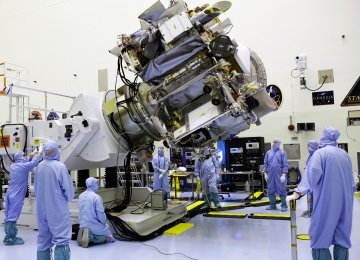After a nearly two-year space chase, NASA’s OSIRIS-REx probe finally has its asteroid target in sight.
OSIRIS-REx, which launched in September 2016, has captured its first imagery of the 500 meters wide space rock Bennu, NASA officials announced on Aug. 24.
The spacecraft snapped the photos on Aug. 17—the same day it officially began its final approach toward Bennu—from a distance of 2.2 million kilometers, Space.com reported.
“I can’t explain enough how much it meant for the team,” OSIRIS-REx principal investigator Dante Lauretta, of the University of Arizona, told reporters. “I know Bennu is only a point of light here, but many of us have been working for years and years and years to get this first image down, and it really represents the beginning of the great scientific expedition that is OSIRIS-REx.”
Bennu will loom larger and larger in OSIRIS-REx’s crosshairs over the next few months. If everything goes according to plan, the probe will arrive at the space rock on Dec. 3. It will perform a series of close flybys, taking measurements that will establish the asteroid’s mass, and then begin circling Bennu on Dec. 31.
That will be no mean feat. “It’s Bennu’s size and small mass that make the navigation challenges on this mission unprecedented, really,” said Michael Moreau, OSIRIS-REx flight dynamics system manager at NASA’s Goddard Space Flight Center in Greenbelt, Maryland. “On December 31, when we insert into orbit, then it will become the smallest planetary object to ever be orbited by a spacecraft.”
For comparison, the asteroid Ryugu, which Japan’s Hayabusa2 spacecraft has been orbiting since late June, is about twice as wide as Bennu, and about six times larger in terms of volume, Lauretta said.
Operation’s Timeline
OSIRIS-REx will study Bennu from orbit for a while, and then spiral down to snag a sizable sample from the rock’s surface in the middle of 2020. The spacecraft will depart Bennu in March 2021, and the sample, encased in a special return capsule, will parachute down to Earth in September 2023.
Bennu is a carbon-rich asteroid, the type that many scientists think delivered the chemical building blocks of life, along with lots of water, to our planet via impacts long ago. So, analyses of the returned sample in labs around the world could reveal key insights about the early solar system and the origin of life on Earth, mission team members have said.
But the $800 million mission will investigate a variety of other questions as well, as its full name suggests. OSIRIS-REx is short for “Origins, Spectral Interpretation, Resource Identification, Security - Regolith Explorer.”
For example, Bennu is a potentially hazardous asteroid; there is a very slight chance the rock could slam into Earth in the late 22nd century. OSIRIS-REx’s observations should help scientists better understand the forces that shape asteroids’ paths through space, and therefore better predict where, exactly, dangerous rocks are going, Lauretta said.






Add new comment
Read our comment policy before posting your viewpoints